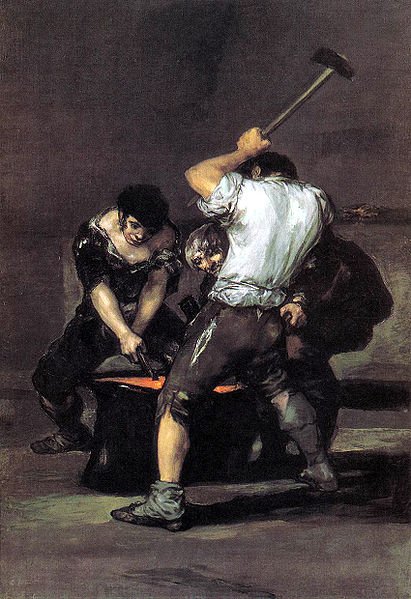| The Forge | |
|---|---|
 |
|
| Artist | Francisco de Goya |
| Year | c. 1817 |
| Medium | Oil on canvas |
| Location | Frick Collection, New York City |
| Dimensions | 71.5 in × 49.25 in |
| 181.6 cm × 125 cm | |
| Famous Paintings by Goya | |
| Saturn Devouring His Son | |
| The Third of May 1808 | |
| La Maja Desnuda | |
| The Sleep of Reason Produces Monsters | |
| Witches’ Sabbath | |
| La Maja Vestida | |
| La Cometa | |
| The Forge | |
| The Dog | |
| Complete Works |
Completed sometime around 1817, The Forge is a large, oil on canvas painting by the Spanish artist, Francisco Goya. Measuring a fraction over 71 by 49 inches, it is currently owned by the small but important Frick museum of art in New York City.
Composition
The painting focuses entirely on three men at work around a blacksmith’s anvil. The character on the left of the painting is crouching behind the anvil, facing forward, and is using a tongs to hold a heated metal object steady on the anvil.
In the center of the painting, with his back to the viewer, is the blacksmith, holding aloft a sledgehammer. The third figure is a man, clearly older than the other two, bent double over the anvil. This figure is only partially visible, and it is unclear what he is doing.
Coloring and Style
The walls and flooring of the forge are depicted in shades of dark grays and blues and are devoid of any features. The blacksmith wears a light-colored shirt with rolled up sleeves, and gray leggings. The left legging has dropped around the forger’s ankle, revealing his calf.
The man with the tongs is dressed completely in black. His shirt has short sleeves and his shoulders are also exposed. The third man is fully clothed. The visible flesh and the blacksmith’s shirt provide the only light coloring in the scene. There is a small splash of vivid red representing the hot metal.
The Louvre
The Forge was not a work commissioned from Goya and it was never sold during the artist’s lifetime. When Goya died, his son inherited the painting. It was acquired by the French king and exhibited in the Louvre until 1851.
Subject Revisited
In 1819, Goya painted Three Men Digging. The positioning and stances of the three subjects is almost identical to those of the subjects in The Forge. The anvil is replaced by a hole the men are digging and the sledgehammer becomes a digging tool.